#red mangrove
Explore tagged Tumblr posts
Text

I was researching how to take care of mangroves, and I discovered this handy guide for saltwater aquarium folks. It never even occurred to me that you could grow red mangroves indoors, let alone inside aquariums!
Anyway, this seems like a handy resource for restoration ecologists, nursery growers, and fish enthusiasts alike.
#mangroves#plants#native plants#red mangrove#estuaries#aquariums#saltwater aquarium#coastal plants#brackish
3 notes
·
View notes
Text
Top care tips for adding red mangroves to your aquarium
Want to discover the best care tips for adding red mangroves to your aquarium?
These tips are simple but will surprise you.
Find out more by checking out this article:
#aquarium plants#aquarium plants for sale#aquatic plants#aquatic plants for sale#benefits of mangroves#mangrove plants#mangrove plants for sale#mangrove propagules#mangrove seeds#mangrove tree#mangrove tree for sale#marine plants#marine plants for sale#red mangrove#red mangrove plants for sale#red mangrove tree#saltwater aquarium plants for sale#saltwater plants
1 note
·
View note
Text
1 note
·
View note
Text
A well-known example of a viviparous species is the red mangrove (Rhizophora mangle) (Figure 18.3).

"Plant Physiology and Development" int'l 6e - Taiz, L., Zeiger, E., Møller, I.M., Murphy, A.
#book quotes#plant physiology and development#nonfiction#textbook#vivipary#viviparous#red mangrove#rhizophora mangle#germination#seeds#seedlings
1 note
·
View note
Text


Mangrove roots with soft corals
Photos by David Hall
#coral#soft coral#mangrove#mangrove roots#colorful coral#marine#ocean#sea#marine life#marine animals#red#red coral#yellow#yellow coral#undersea#underwater photography#nature
53 notes
·
View notes
Text
oh oh. shoutout to my dreamself who decided to just Make An Abnormality.
it was called This Place Won't Stay, and its a weird looking salmon guy. think wellcheers but. fish. it looked very silly but spoke with the weight of someone who'd seen death coming for it and did not flinch. it didn't seem to Like speaking to anybody, but seemed to out of obligation, ending every sentence with its desire to get back to work, alone.
nothing else was shown or spoken, but it had a feeling. something about work put into a cause, sunk cost fallacy, complete and total dedication to a task that inevitably ends with your own demise. yet, it is still work to be done, and yours alone. complete and total self-reliance, and resignation to a greater purpose. instinct, duty, and determination. the grasp of Nature and Legacy. something like that.
#i think it had something to do with trees too. maybe mangroves? i think it grew them. but i dont rember itwas a few days ago =w=#ifeel like i could extrapolate more from it; it feels very. Very. it had a lot of unspoken facets.#piktalk#projmoon#oh ! it was one of those green and red salmon also :]#it seemed to feel a lot on the concept of Impermanence too. entropy. its inevitable link to growth; cycles.#'this place wont stay' as in 'this place wont grow itself.' as in 'i am the pillar this all rests on' as in 'i will not see this ending.'#ifthat makes sense. ilike this fish :]
15 notes
·
View notes
Text
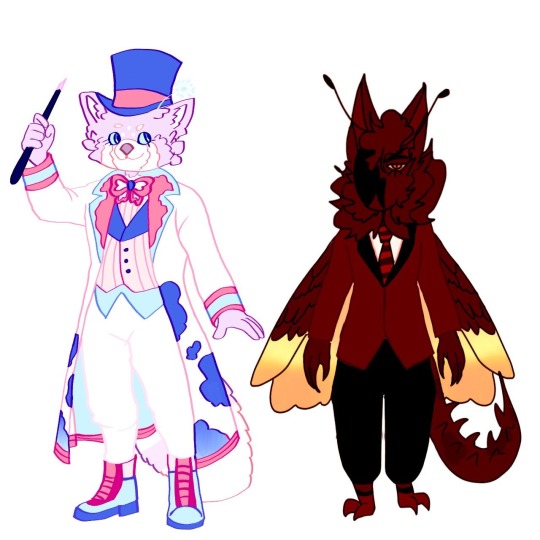
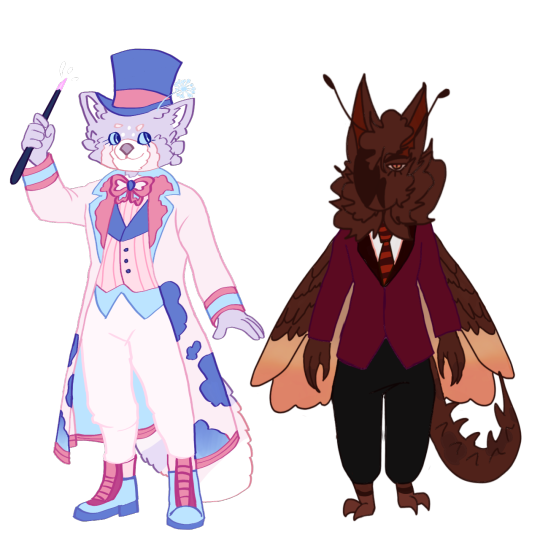
#my art#furry art#oc art#small artists#red panda#owl#cockroach#anthro animals#anthro#ocs#oc: mangrove#oc: paige
12 notes
·
View notes
Text
IDK I'm just particularly happy about how this new world is going :)
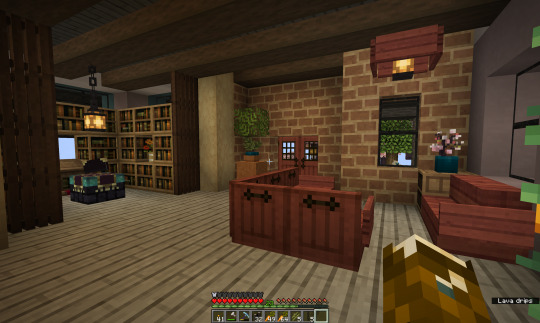


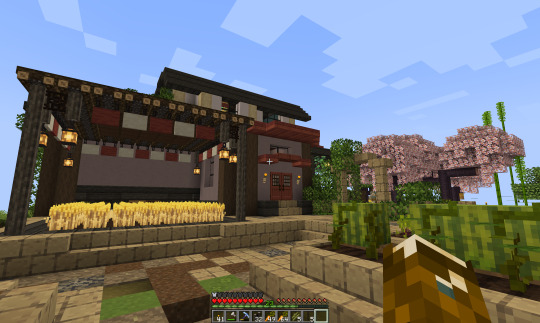
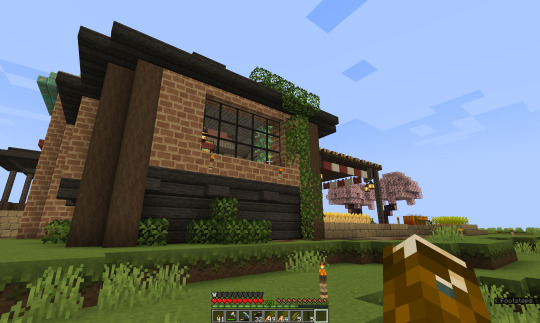
#Hanging signs are so much better as banner rope things than banners are#I'm doing more of a natural feel on my building where I usually go overboard with the stone bricks and make things more idk... formal?#I <3 mud bricks#the resource pack is mizunos of course. that natural brick texture is a hard to get one but I love it#It's a merged slab texture of two cut red sandstone. I have done so much digging. thank u teleport but it's. so much#Mangroves also suck ass to cut down. btw.#minceraft#minecraft on main
10 notes
·
View notes
Text

Red mangroves in Belize.
PHOTOGRAPH BY BRIAN J. SKERRY, NAT GEO IMAGE COLLECTION
16 notes
·
View notes
Text
Daily fish fact #302
Mangrove red snapper!

Like its name suggests, it inhabits mangrove forests where it hunts as an ambush predator! Its colouration can vary anywhere from orange, to bronze, to dark reddish brown.
#fish#fishfact#fish facts#fishblr#marine life#marine animals#marine biology#sea life#sea creatures#sea animals#snapper#red snapper#mangrove red snapper#grey snapper#mangrove jack
85 notes
·
View notes
Note
didn't know who you were but your skin was so tumblr sexyman coded I couldn't resist voting
then I saw a post about you not having youtube or twitch, went "wait what" and went for the deep dive into darkwoods smp tag
love you and your silly friends! congrats on 33% <3
answering this one a bit late but THANK YOU!!! <3 im glad our silly little server and silly little campaign has entertained people so much, everyone has really been so wonderful and supportive and i can’t thank you all enough.
honestly i think saint’s skin was a big help getting as far as i did hdhskdgksdg. so many people in the tags mentioned going off looks alone. i got lucky by having the cool one with the suspenders and all as the one chosen to represent me on the actual poll bc some of my other skins are not nearly as sexyman-coded.
#funnily enough the skin from the polls is not my current default. usually it’s a sort of incomprehensible dark grey outfit#i might start using it as my default. it was meant to be vaguely inspired by mangrove wood which is why there’s red tones in it#i just don’t live anywhere near a mangrove swamp rn bc i live in an area of the server that’s been around since 1.17#darkwoods smp#saintsweep#anon#ask
7 notes
·
View notes
Text
Why are the leaves on my mangrove plants turning yellow?
Are you wondering why your mangrove aquarium plants have leaves that are turning yellow?
The answer might surprise you.
Read this article below to find out the truth:
#aquarium plants#aquarium plants for sale#aquatic plants#aquatic plants for sale#benefits of mangroves#mangrove plants#mangrove plants for sale#mangrove propagules#mangrove seeds#mangrove tree#mangrove tree for sale#marine plants#marine plants for sale#red mangrove#red mangrove plants for sale#red mangrove tree#saltwater aquarium plants for sale#saltwater plants
1 note
·
View note
Text
“why are floridians like that” well ysee when I was a lad I licked too many mangroves
#florida#it’s true btw#there are three species of mangroves in florida#black red and white mangroves#and the way you can identify a black mangrove#is that the leaves excrete salt bc they grow in brackish water#so you can lick the leaves and they taste salty
5 notes
·
View notes
Text

Cute apple house. I think I’m going to try building food and animal themed buildings with their inspirations inside. This one has an oak tree inside it. Starting simple. A little intimidated to make a sheep pen inside a sheep figure, but at least the sheep design is fairly simple. No idea how the cow house is going to turn out, haha.
#minecraft#not the best pic but i'm working on taking better screenshots in minecraft#i saw someone else do a cute apple house and got inspired to give it a shot#had to experiment with the blocks a bit tho#red terracotta was too dull#so this is mostly red concrete red wool and mangrove planks since i needed stairs for the angles#oh green wool for the leaf#and stripped dark oak logs plus one dark oak staircase for the stem#this is my first time making a 'food house' on minecraft#i've made animal statues before#well not a ton#just a sheep#and then technoblade as a pig with a crown and cape#but i think the apple turned out alright#the shape was tricky but i think this is a decent apple shape
3 notes
·
View notes
Text
How to care for the spotted scat
One of the iconic fishes for the brackish aquarium, is the spotted or common scat, Scatophagus argus. It is sometimes called a butterfish, although unrelated fishes share that name. The so-called red scat is sometimes traded as a seperate species or race of S. argus, however it is demonstrated to be a naturally ocurring color morph of the spotted scat. Most spotted scats belong to the more typical morph, which is traded as the green scat, or just the scat. This is because the other species appear too rarely in the aquarium trade to have become familiar to aquarists.
The typical length for a mature S. argus, both in the wild and in the aquarium, is 15 to 20 centimeters or 6 to 8 inches. A scat that is 30 centimeters or 12 inches long is considered large, and the recorded length is 38 centimeters, or about 15 inches. This is a venomous fish with a catholic diet, distributed in the Indo-West Pacific region, in a swathe from the Persian Gulf to Japan and Australia. The primary habitat of S. argus is mangrove estuaries, where it associates with mangrove flora.
Mature fish are also found in shallow, inshore marine environments, where they associate with seagrass, rather than reef-building corals. Wether in fresh or brackish water, they are found in areas of muddy substrate. These fish may be numerous in areas of reduced salinity, but records from non-estuarine stretches of rivers are rare. They do frequent upstream stretches of streams, but they remain close to the estuary. Although S. argus can survive in good health when it is maintained in freshwater, I do not consider them a freshwater fish, at any stage in their life cycle.
There are in fact a few related species all called scats, belonging to the extant sister genera Scatophagus and Selenotoca, and the fossil record of the scat clade extends back to the Eocene epoch. Zoologically the scats are part of the acanthuriform nexus of fishes, which is mostly marine, and includes the tangs, butterlyfishes and angelfishes of the reef, among others. Among this group the scats have a reputation as unusually euryhaline, capable of frequenting both fresh and salt waters. Addituonally S. argus also been noted to have broad tolerance of temperature and pH.
Much confusion exists among aquarists, surrounding the salinity needs and optimums of S. argus. Despite their hardiness, unfortunate S. argus suffer and die in home aquariums, or skulk alone in a store. Often aquarists are daunted from purchasing a scat, by misinformation about their needs. Thai aquaculturists report that the culture of S. argus requires a specific gravity, of at least 1.002, or a 'low end brackish' setting. Although scats can be acclimatised to life in true freshwater, it is not their natural habitus.
In a study of wild scats in a mangove environment, the older scats lived where the specific gravity was around 1.02. Juvenile scats were found upstream of them, where tidal influence on salinity was less, and the spe ific gravity was 1.02. Elsewhere it was found that the embryonic development within scat eggs, was optimised when the specific gravity is 1.01. Although some sources insist that scats may only be accommodated in freshwater, if the water parameters are hard and alkaline, collection data shows wild scats are present where the pH may be as low as about 7. It is true that scats are not found where the water has the soft, acidic parameters favoured by so many popular freshwater species.
The genus name Scatophagus, which is obviously abbreviated to the vernacular 'scat', means an eater of faeces. This alleged feeding habit, which causes much amusement, actually remains unproven, although scats have adapted to the human presence on the coast, by frequenting harbours and wharfs. There people dump their latrine and other waste into the water, in the area where fishes such as scats were feeding. Although they might not seek faeces to eat, I feel sure that they obtain some benefit from byproducts of human presence, as do rats and mice, pigeons, seagulls, and the like above water.
Juvenile scats, particularly, are known to consume organic detritus, and mud is intentionally ingested by this species, because it is recovered among their other gut contents. That these scats scavenge opportunistically is the most likely explanation for the presence of fish scales in their gut contents. Because scats are unlikely to nip scales from live fishes swimming by, the most likely source of the ingested scales was nibbling at fish carrion when they encountered it.
S. argus has a very broad dietary range, and the composition of its diet changes with growth. Juvenile scats consume more plankton, but as they grow, they switch to intensify their grazing behaviors, and for this reaon their mouths become subterminal in position. Their diets include a variety of items, from fish eggs, to arthropods, to sessile fauna, and both micro- and macroalgae. Although they are thus most often classed as omnivorous fishes, S. argus has the expanded gut of a herbivorous fish, and the form and function of its teeth and face are optimised for grazing activities.
Depite their strongly herbivorous leanings, a part of the natural S. argus diet includes animals such as sponges, bryozoans, hydroids, and tunicates. One source reports the inclusion of coral and anemone polyps in their wild diet. Unfortunately, the size and systematics of the polyps consumed, was not reported in the paper. Although some saltwater aquarists have maintained older S. argus in reef tanks, where they graze on algae and sessile organisms found on 'live rock', they sometimes nip at delicate, sessile ornamentals such as the popular feather duster worms.
Feeding S. argus in the aquarium is not at all difficult, although the diet provided for them, must be rich in algal or other vegetable material, of the sort offered to herbivorous fishes. Their aquarium environment should be a mangrove biotope, with a soft substrate and wood as decoration. Alternatively the mature S. argus are well suited to a true saltwater lagoon biotope. Such a tank has marine water parameters, a soft substrate, and some calcareous rockwork in the aquascape.
S. argus are regarded as semi-aggressive yet gregarious with their own kind, faring best when housed in a group of conspecifics. Each fish will need not only swimming space, but also a number of retreats from one another. Unfortunately S. argus, being a herbivorous fish, is not unlikely to attack ornamental plants, once it has matured into a more herbivorous growth stage. This means that live plants, including marine macoalgae, will be nibbled or outright devoured, unless they are unpalatable to S. argus.
Juvenile S. argus will require a 'low end brackish' specific gravity, but older fishes occur in 'mid range brackish' to marine environments. Although comparatively few aquarium fishes are inhabitants of brackish waters, there are a variety of peaceful species that are suitable for sharing such a brackish, mangrove biotope. When transferring scats, or any other euryhaline organisms between two aquariums, they must be slowly acclimatised between the two different levels of salinity. This is so that physiological changes can take place, and to prevent osmotic shock.
In their native range, S. argus are found where the water temperature may be as low as 20 degrees centigrade in some months, but up to 29 degrees during other parts of the year. They begin to experience thermal stress, ony at something like 33 degrees, and they can temporarily tolerate such temperatures, but not higher temperatures of around 40 degrees. Like many fish and crabs from mangrove environments, S. argus is well used to thriving at temperatures that are a little higher than those in the average tropical aquarium, which is usually 24 or 25 degrees. Yet S. argus also fares fine at such an ordinary tropical tank temperature.
#Scatophagus argus#spotted scat#common scat#green scat#red scat#misunderstood fish#brackish fish#oddballs#marine fishes#mangrove biotope
0 notes
Text
"In China, a landscape architect is reimagining cities across the vast country by working with nature to combat flooding through the ‘sponge city’ concept.
Through his architecture firm Turenscape, Yu has created hundreds of projects in dozens of cities using native plants, dirt, and clever planning to absorb excess rainwater and channel it away from densely populated areas.
Flooding, especially in the two Chinese heartlands of the commercial south and the agricultural north, is becoming increasingly common, but Yu says that concrete and pipe solutions can only go so far. They’re inflexible, expensive, and require constant maintenance. According to a 2021 World Bank report, 641 of China’s 654 largest cities face regular flooding.
“There’s a misconception that if we can build a flood wall higher and higher, or if we build the dams higher and stronger, we can protect a city from flooding,” Yu told CNN in a video call. “(We think) we can control the water… that is a mistake.”
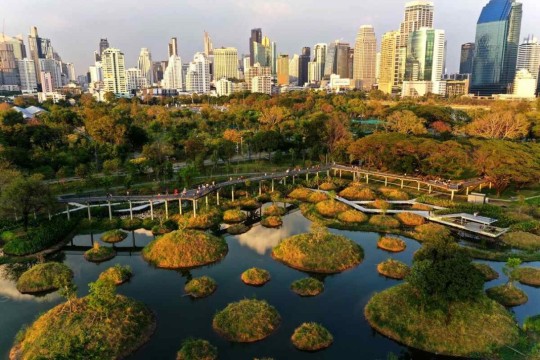
Pictured: The Benjakitti Forest Park in Bangkok
Yu has been called the “Chinese Olmstead” referring to Frederick Law Olmstead, the designer of NYC’s Central Park. He grew up in a little farming village of 500 people in Zhejiang Province, where 36 weirs channel the waters of a creek across terraced rice paddies.
Once a year, carp would migrate upstream and Yu always looked forward to seeing them leap over the weirs.
This synthesis of man and nature is something that Turenscape projects encapsulate. These include The Nanchang Fish Tail Park, in China’s Jiangxi province, Red Ribbon Park in Qinghuandao, Hebei province, the Sanya Mangrove Park in China’s island province of Hainan, and almost a thousand others. In all cases, Yu utilizes native plants that don’t need any care to develop extremely spongey ground that absorbs excess rainfall.

Pictured: The Dong’an Wetland Park, another Turescape project in Sanya.
He often builds sponge projects on top of polluted or abandoned areas, giving his work an aspect of reclamation. The Nanchang Fish Tail Park for example was built across a 124-acre polluted former fish farm and coal ash dump site. Small islands with dawn redwoods and two types of cypress attract local wildlife to the metropolis of 6 million people.
Sanya Mangrove Park was built over an old concrete sea wall, a barren fish farm, and a nearby brownfield site to create a ‘living’ sea wall.
One hectare (2.47 acres) of Turenscape sponge land can naturally clean 800 tons of polluted water to the point that it is safe enough to swim in, and as a result, many of the sponge projects have become extremely popular with locals.
One of the reasons Yu likes these ideas over grand infrastructure projects is that they are flexible and can be deployed as needed to specific areas, creating a web of rain sponges. If a large drainage, dam, seawall, or canal is built in the wrong place, it represents a huge waste of time and money.

Pictured: A walkway leads visitors through the Nanchang Fish Tail Park.
The sponge city projects in Wuhan created by Turenscape and others cost in total around half a billion dollars less than proposed concrete ideas. Now there are over 300 sponge projects in Wuhan, including urban gardens, parks, and green spaces, all of which divert water into artificial lakes and ponds or capture it in soil which is then released more slowly into the sewer system.
Last year, The Cultural Landscape Foundation awarded Yu the $100,000 Oberlander Prize for elevating the role of design in the process of creating nature-based solutions for the public’s enjoyment and benefit."
-via Good News Network, August 15, 2024
#china#wuhan#thailand#bangkok#landscape#wetlands#sponge city#landscape architecture#flooding#climate action#parks#public park#green architecture#sustainability#good news#hope
961 notes
·
View notes